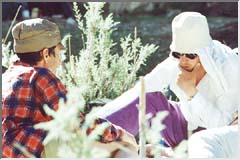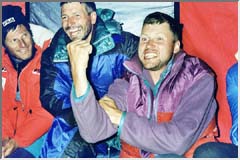That's why, again, it's hard to compare our work with the work of the
international expedition. I agree with Ivan on some points. Our way of
organizing the expedition to such a severe mountain as K2 via its North
Ridge showed its advantages. But the question, 'How to plan our future
expeditions?' is still not clear to me.

The big mistake was to start the expedition that late. We should have
gone to Karakoram much earlier because of the rivers and seasons in the
mountains.

Summing up, I'll try to compile a list of a successful expedition points
on the basis of their priorities, according to my understanding:
-
The will of an organizer. Only if there is somebody able to keep, to draw
together the mass of questions, events, people, and other things the expedition
consists of, then the expedition can take place. In other cases everything
dissolves naturally. Thank God, there is Ivan Dusharin in Togliatti. By
the way, Ivan was very precise expressing his feeling about the expedition
as a master's feeling. Each expedition must have its master;
-
The team. You can easily get other resources, but not that one. You have
to create it working together for many years;
-
Money;
-
Time. There has to be just enough time (neither much nor little). Each
process has its own inertia, at the same time you shouldn't delay. I had
one American project which disappeared after a year and a half of preparations.
-
Experience.
Do we have all these things in our new expedition? Time will show. We had
done everything we could. For the Nanga Parbat expedition we formed a team
consisting of Ivan, me, Andrei Mariev, Sasha Dosaev and our permanent doctor
Luba Shvedova, Carlos Buhler and my brother Slava, the leader of the Everest
expedition. We'll try to make a different expedition, and let God help
us! |


